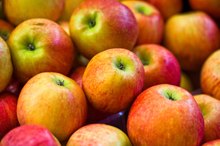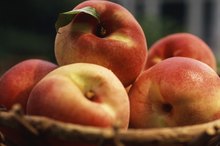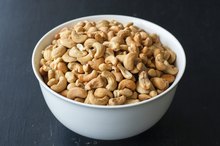What does fact checked mean?
At Healthfully, we strive to deliver objective content that is accurate and up-to-date. Our team periodically reviews articles in order to ensure content quality. The sources cited below consist of evidence from peer-reviewed journals, prominent medical organizations, academic associations, and government data.
- National Diabetes Education Program: The Facts About Diabetes: A Leading Cause of Death in the U.S.
- Harvard Medical School: Glycemic Load for 100 Foods
The information contained on this site is for informational purposes only, and should not be used as a substitute for the advice of a professional health care provider. Please check with the appropriate physician regarding health questions and concerns. Although we strive to deliver accurate and up-to-date information, no guarantee to that effect is made.
List of Good Carbs for Diabetics
According to the National Diabetes Education Program, 8.3 percent of the U.S. population has diabetes. Whether you have this disease or not, limiting your high glycemic index -- GI -- carbs is a good habit to establish. The GI and glucose load -- GL -- indicate how foods affect your blood sugar and insulin levels. The lower the GI and GL, the better.
Glucose Index and Glucose Load
When you eat a meal, your blood sugar rises and falls. The quality and the quantity of the carbs you eat determine how high your blood sugar rises and how long it remains that way. The GI value defines the quality of the carbs. This value can be from 0 to 100, with 55 and below considered low on the index scale and 70 and above considered high. The GL value defines both the quality and the quantity of carbohydrate in one value, making it the best way to determine how a particular food will affect your blood sugar and insulin levels.
The formula is: GL = (GI x the amount of carbohydrate) divided by 100.
For example, if an average apple has a GI of 40 and it contains 15 grams of carbohydrate, the GL value is 6: GL = 40 x 15/100 = 6 g.
- When you eat a meal, your blood sugar rises and falls.
- For example, if an average apple has a GI of 40 and it contains 15 grams of carbohydrate, the GL value is 6: GL = 40 x 15/100 = 6 g.
Fruits
What Diabetics Eat to Get Energy
Learn More
According to the Harvard Medical School, good whole fruits to consider for a low-GI carb include apples, prunes and grapefruit 3. A medium-sized apple has a GI value of 39 and a GL value of 6. Three medium-sized prunes have a GI value of 29 and a GL value of 10. An average grapefruit has a GI value of 25 and a GL value of 3.
- According to the Harvard Medical School, good whole fruits to consider for a low-GI carb include apples, prunes and grapefruit 3.
- Three medium-sized prunes have a GI value of 29 and a GL value of 10.
Vegetables
Most vegetables are low on the GI and GL scale, such as dark leafy greens, broccoli, squash and other low-starch veggies. Carrots have a GI value of 35 for 80 grams, and a GL value of 2. An average yam has a GI value of 54 and a GL value of 20, making it a better option than your typical russet potato.
- Most vegetables are low on the GI and GL scale, such as dark leafy greens, broccoli, squash and other low-starch veggies.
- An average yam has a GI value of 54 and a GL value of 20, making it a better option than your typical russet potato.
Grains
Low-Glycemic Foods List
Learn More
Believe it or not, you can enjoy grains on a low-GI diet. The one grain that packs the most nutrition is quinoa. In a 150-gram serving, its GI value is 53 and its GL value is 13. It may be slightly high on the GL scale, but the nutrition it offers is well worth the cost. Barley offers a lower cost with its GI at 28 and its GL at 12 for a 150-gram serving. Brown rice and whole-wheat kernels are also good choices.
- Believe it or not, you can enjoy grains on a low-GI diet.
- It may be slightly high on the GL scale, but the nutrition it offers is well worth the cost.
Beans and Nuts
Not only are beans and nuts high in protein and fiber, they weigh in with an impressive low GI value. Fifty grams of peanuts have a GI of 7 and a 0 GL. A 150-gram serving of soybeans has a GI of 15 with a 1 GL. Lentils and chickpeas also offer a low GI/GL index.
- Not only are beans and nuts high in protein and fiber, they weigh in with an impressive low GI value.
- Fifty grams of peanuts have a GI of 7 and a 0 GL.
Related Articles
References
- University of Sydney: Glycemic Index
- Harvard Medical School: Glycemic Load for 100 Foods
- National Institutes of Health. MedlinePlus. Glycemic index and diabetes.
- The University of Sydney. About the Glycemic Index.
- Glycemic Index Foundation. About the Glycemic Index.
- Glycemic Index Foundation. Glycemic Load.
- American Diabetes Association. Glycemic targets: Standards of Medical Care in Diabetes-2020. Diabetes Care. 2020;43(Suppl 1):S66-S76. doi:10.2337/dc20-S006
- American Diabetes Association. Lifestyle management: Standards of medical care in diabetes-2019. Diabetes Care. 2019;42(Suppl 1):S46‐S60. doi:10.2337/dc19-S005
- Shukla A, Iliescu R, Thomas C, Aronne L. Food order has a significant impact on postprandial glucose and insulin levels. Diabetes Care. 2015; 38(7):e98-e99. doi:10.2337/dc15-0429
Writer Bio
Rowena has been in the natural medicine field since 2008 and holds a certification in both nutrition and alternative medicine. She and her mate, Gregg, owned a natural medical office for four years where she practiced. She enjoys wild foraging, making medicines from plants, and salves from herbs and oils. In her opinion, there isn't a plant that exists that does not provide some type of medicine.









